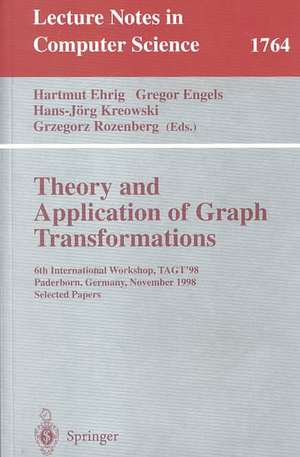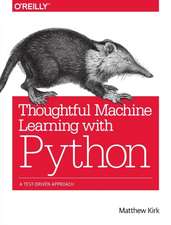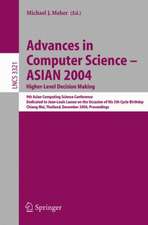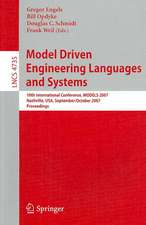Theory and Application of Graph Transformations: 6th International Workshop, TAGT'98 Paderborn, Germany, November 16-20, 1998 Selected Papers: Lecture Notes in Computer Science, cartea 1764
Editat de Hartmut Ehrig, Gregor Engels, Hans-Jörg Kreowski, Grzegorz Rozenbergen Limba Engleză Paperback – 2 mar 2000
Din seria Lecture Notes in Computer Science
- 20%
 Preț: 1061.55 lei
Preț: 1061.55 lei - 20%
 Preț: 340.32 lei
Preț: 340.32 lei - 20%
 Preț: 341.95 lei
Preț: 341.95 lei - 20%
 Preț: 453.32 lei
Preț: 453.32 lei - 20%
 Preț: 238.01 lei
Preț: 238.01 lei - 20%
 Preț: 340.32 lei
Preț: 340.32 lei - 20%
 Preț: 438.69 lei
Preț: 438.69 lei -
 Preț: 449.57 lei
Preț: 449.57 lei - 20%
 Preț: 343.62 lei
Preț: 343.62 lei - 20%
 Preț: 148.66 lei
Preț: 148.66 lei - 20%
 Preț: 310.26 lei
Preț: 310.26 lei - 20%
 Preț: 256.27 lei
Preț: 256.27 lei - 20%
 Preț: 645.28 lei
Preț: 645.28 lei - 17%
 Preț: 427.22 lei
Preț: 427.22 lei - 20%
 Preț: 655.02 lei
Preț: 655.02 lei - 20%
 Preț: 307.71 lei
Preț: 307.71 lei - 20%
 Preț: 1075.26 lei
Preț: 1075.26 lei - 20%
 Preț: 591.51 lei
Preț: 591.51 lei -
 Preț: 381.21 lei
Preț: 381.21 lei - 20%
 Preț: 337.00 lei
Preț: 337.00 lei - 15%
 Preț: 438.59 lei
Preț: 438.59 lei - 20%
 Preț: 607.39 lei
Preț: 607.39 lei - 20%
 Preț: 538.29 lei
Preț: 538.29 lei -
 Preț: 389.48 lei
Preț: 389.48 lei - 20%
 Preț: 326.98 lei
Preț: 326.98 lei - 20%
 Preț: 1414.79 lei
Preț: 1414.79 lei - 20%
 Preț: 1024.44 lei
Preț: 1024.44 lei - 20%
 Preț: 579.30 lei
Preț: 579.30 lei - 20%
 Preț: 575.48 lei
Preț: 575.48 lei - 20%
 Preț: 583.40 lei
Preț: 583.40 lei - 20%
 Preț: 763.23 lei
Preț: 763.23 lei - 15%
 Preț: 580.46 lei
Preț: 580.46 lei - 17%
 Preț: 360.19 lei
Preț: 360.19 lei - 20%
 Preț: 504.57 lei
Preț: 504.57 lei - 20%
 Preț: 172.69 lei
Preț: 172.69 lei - 20%
 Preț: 369.12 lei
Preț: 369.12 lei - 20%
 Preț: 353.50 lei
Preț: 353.50 lei - 20%
 Preț: 585.88 lei
Preț: 585.88 lei -
 Preț: 410.88 lei
Preț: 410.88 lei - 20%
 Preț: 596.46 lei
Preț: 596.46 lei - 20%
 Preț: 763.23 lei
Preț: 763.23 lei - 20%
 Preț: 825.93 lei
Preț: 825.93 lei - 20%
 Preț: 649.49 lei
Preț: 649.49 lei - 20%
 Preț: 350.21 lei
Preț: 350.21 lei - 20%
 Preț: 309.90 lei
Preț: 309.90 lei - 20%
 Preț: 122.89 lei
Preț: 122.89 lei
Preț: 343.29 lei
Preț vechi: 429.11 lei
-20% Nou
Puncte Express: 515
Preț estimativ în valută:
65.71€ • 67.71$ • 55.47£
65.71€ • 67.71$ • 55.47£
Carte tipărită la comandă
Livrare economică 01-15 martie
Preluare comenzi: 021 569.72.76
Specificații
ISBN-13: 9783540672036
ISBN-10: 3540672036
Pagini: 516
Ilustrații: X, 506 p.
Dimensiuni: 155 x 235 x 27 mm
Greutate: 0.72 kg
Ediția:2000
Editura: Springer Berlin, Heidelberg
Colecția Springer
Seria Lecture Notes in Computer Science
Locul publicării:Berlin, Heidelberg, Germany
ISBN-10: 3540672036
Pagini: 516
Ilustrații: X, 506 p.
Dimensiuni: 155 x 235 x 27 mm
Greutate: 0.72 kg
Ediția:2000
Editura: Springer Berlin, Heidelberg
Colecția Springer
Seria Lecture Notes in Computer Science
Locul publicării:Berlin, Heidelberg, Germany
Public țintă
ResearchCuprins
Graph Languages.- Some Remarks on the Generative Power of Collage Grammars and Chain-Code Grammars.- Tree Languages Generated by Context-Free Graph Grammars.- Neighborhood Expansion Grammars.- Neighborhood-Preserving Node Replacements.- Graph Theory.- Complexity Issues in Switching of Graphs.- The Power of Local Computations in Graphs with Initial Knowledge.- Categorical Approaches.- Double-Pullback Graph Transitions: A Rule-Based Framework with Incomplete Information.- Double-Pushout Approach with Injective Matching.- Node Replacement in Hypergraphs: Translating NCE Rewriting into the Pullback Approacht.- Pushout Complements for Arbitrary Partial Algebras.- Concurrency and Distribution.- Unfolding of Double-Pushout Graph Grammars is a Coreflection.- Local Views on Distributed Systems and Their Communication.- Dynamic Change Management by Distributed Graph Transformation: Towards Configurable Distributed Systems.- A Framework for NLC and ESM: Local Action Systems.- Artificial Intelligence.- Redundancy and Subsumption in High-Level Replacement Systems.- Knowledge Representation and Graph Transformation.- Utilizing Constraint Satisfaction Techniques for Efficient Graph Pattern Matching.- Visual Languages.- Conceptual Model of the Graphical Editor GenGEd for the Visual Definition of Visual Languages.- From Formulae to Rewriting Systems.- Hypergraphs as a Uniform Diagram Representation Model.- Specification Concepts.- Story Diagrams: A New Graph Rewrite Language Based on the Unified Modeling Language and Java.- A Fully Abstract Model for Graph-Interpreted Temporal Logic.- More About Control Conditions for Transformation Units.- Integrity Constraints in the Multi-Paradigm Language PROGRES.- Modularity and Refinement.- A Framework for Adding Packages to Graph Transformation Approaches.- Refinements of Graph Transformation Systems via Rule Expressions.- Simple Modules for Grace.- UML Packages for PROgrammed Graph REwriting Systems.- Incremental Development of Safety Properties in Petri Net Transformations.- Software Engineering.- Using Graph Transformation Techniques for Integrating Information from the WWW.- A Model Making Automation Process (MMAP) Using a Graph Grammar Formalism.- Graph-Based Models for Managing Development Processes, Resources, and Products.- Deriving Software Performance Models from Architectural Patterns by Graph Transformations.
Caracteristici
Includes supplementary material: sn.pub/extras





















